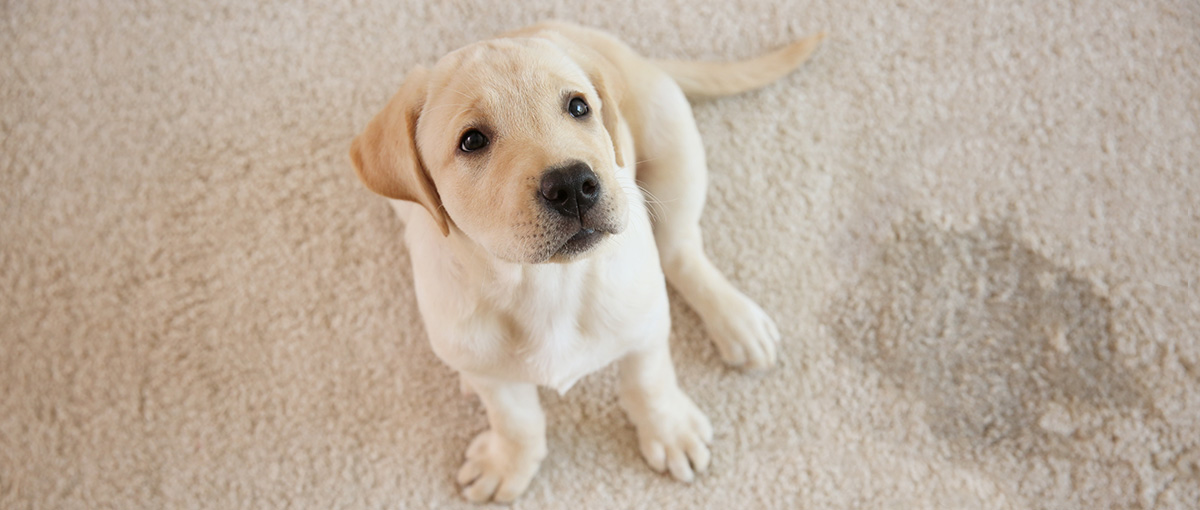Our pet treatment can include, vomit, poop, and pee, but removing urine is by far the most difficult. There is not an “all-in-one fix” product to get this done in one shot. At times it may take multiple cleanings to remove the stain or stains. There are also times when the damages are so severe the carpet needs to just be replaced, along with the pad and having the subfloor cleaned and sealed to remove the smell entirely.
Usually, the first 24 hours after an accident is the best time to treat a pet stain. I’m most cases urine is acid for the first 24 hrs and then turned alkaline after it drys. Depending on how long the stain has been there depends on how it is to be cleaned. At times the stain could have bleached the carpet if it has been left for a long time. It’s recommended for urine to have the homeowner blot up as much urine with a dry rag, spray hydrogen peroxide and 10 mins after applying baking soda to dwell overnight and then vacuum up the following morning. Note – none of this can be done on a natural fiber such as wool. Next step is to call us and have us come clean stain ASAP.
Our cleaning process:
- Examine stain and severity. Explain that we will do our absolute best, but we cannot guarantee that the stain and smell can be removed 100%. Multiple treatments and cleanings may be needed, and at times when damage is so severe, replacement may be the better option.
- Ask questions and how long has it been there, type of pet, pets health, diet… all these can have a factor in how the stain may need to be treated.
- Apply pet odor neutralizer to stain. May need to be injected below the carpet as well.
- Apply product to remove yellowish pee color, dwell time, flush and rinse with a vacuum system. This may take a few times.
- Apply live active enzyme treatment to stain. This is to be applied, so the area is saturated. Leave enzyme to do its job and help break down Uric acid. Possibly apply one more treatment of odor neutralizer.
Many people unfamiliar with the problem of cleaning urine stains try to clean up pee as they would any other stain, only to find out later it didn’t work. In fact, using traditional household cleaners on urine actually “sets” the stain. This makes the stain even more challenging to remove with proper enzyme cleaners. Home-made mixtures or typical household cleaners do not contain the required ingredients to remove ALL the components of cat urine. Vinegar and baking soda work to neutralize the odor temporarily and hydrogen peroxide are 30% more oxidizing than chlorine. But urine is composed of things that REQUIRE enzymes to break down the chemical bonds.
PET URINE IS COMPOSED OF:
- Urea
- Urobilin/Urobilinogen (urobilin is the pigment that causes the color)
- Uric Acid
- Sodium
- Other electrolytes
- Creatinine
- Pheromones
- Bacteria – typically 5 different strains
When urine dries, the urea is broken down by the bacteria. This is what makes it smell like ammonia. As it decomposes further, it releases thiols that cause an odor to become worse. (It is the thiols in skunk spray that make it SO potent and difficult to remove).
The urea and urobilin/urobilinogen are not hard to clean. Urea, urobilin/urobilinogen, creatinine and the pheromones are water soluble and store bought carpet cleaners will deal with these easily. Also, common chemicals around the house can also help with the spots and odors, such as hydrogen peroxide, vinegar, and baking soda. However, uric acid and its salts are still present, which is why professional cleaning is preferable to eliminate the issues completely.
Due to the uric acid component of cat urine, the smell of cat pee has the potential to last for over a decade. This is why, again, it is important to use a professional cleaner that can break down the uric acid. Common home cleaners do not have the chemical capability to break down the uric acid. Deodorizers and cleaners will only temporarily eliminate the smell, but if the carpet gets wet or is exposed to humidity, the salts in the uric acid will reform and release the unpleasant smell.
We use an enzyme cleaner to break down the uric acid into carbon dioxide and ammonia. These are both gasses that will evaporate quickly, thus removing the smell.
